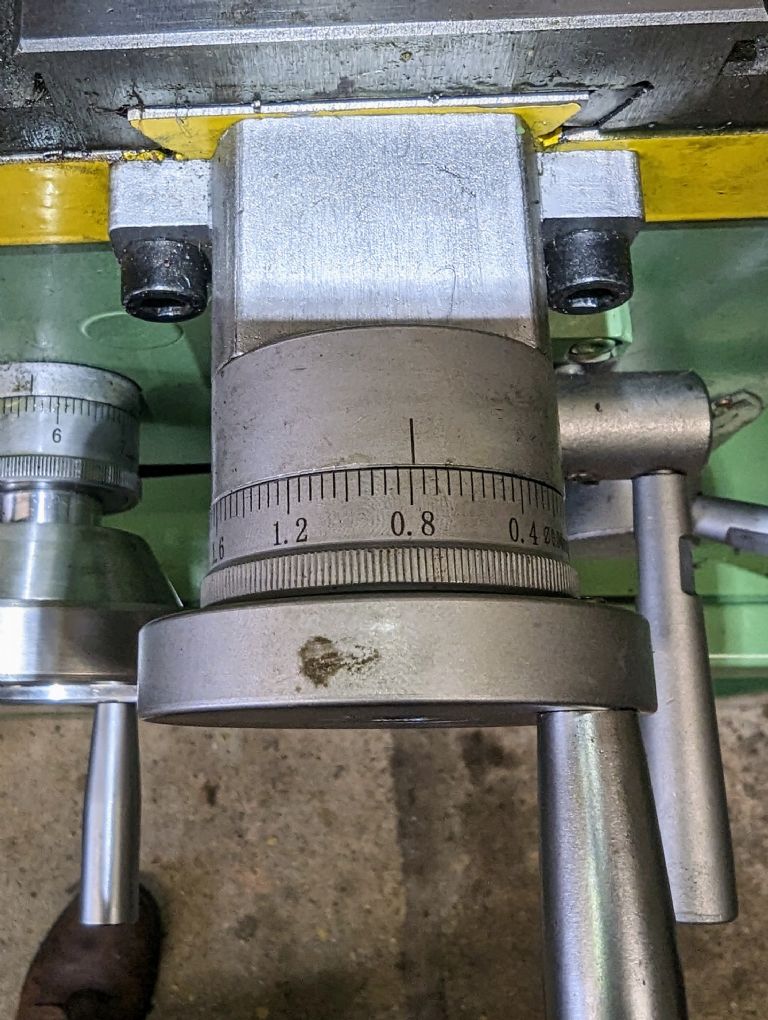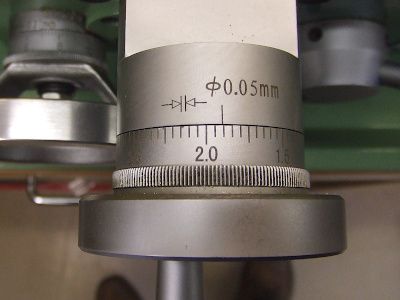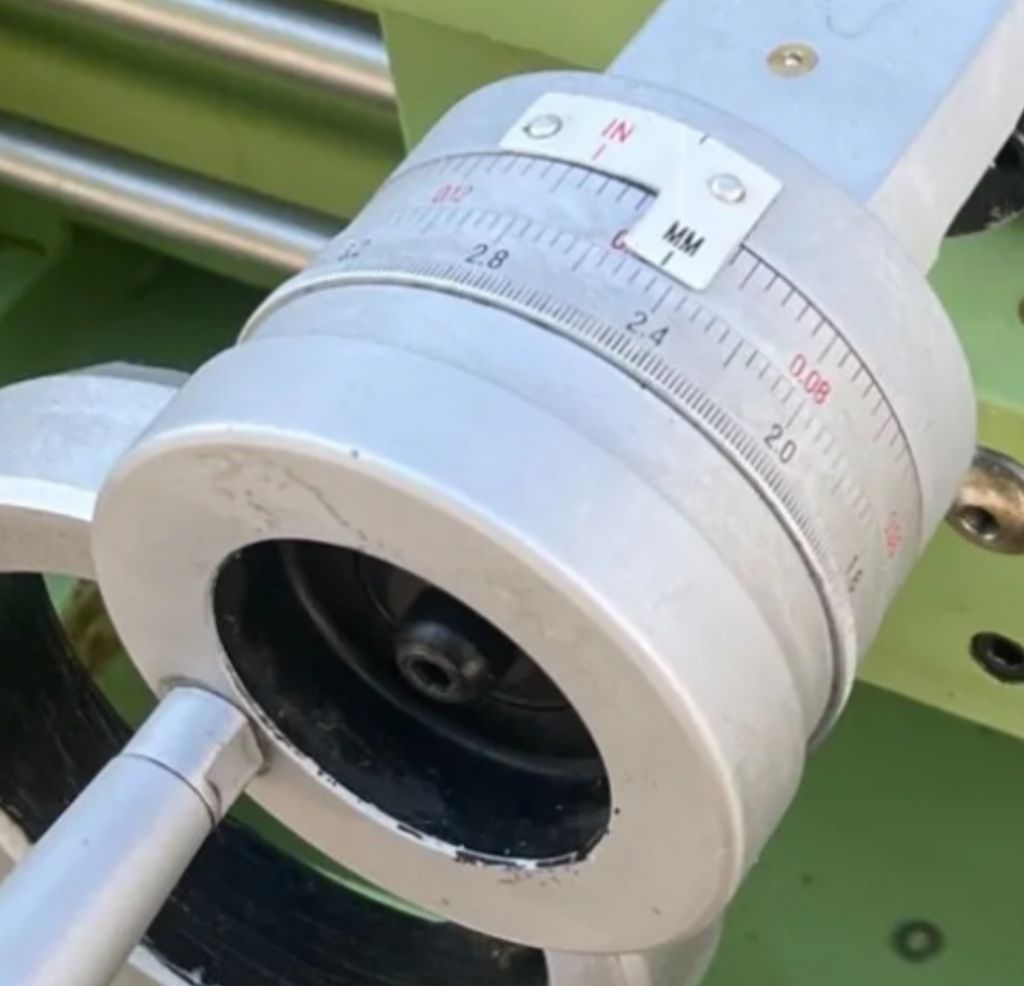Is this a Warco / Metric thing...or am I just out of date?
| Paul Wirdnam | 18/04/2023 15:16:53 |
| 12 forum posts 9 photos | Finally got to do some serious turning on my new WM250V...but have been scratching my head why I can't seem to take the right size cut. Never had this problem during the 40 years of using my old imperial Sheldon.... At first I thought it was my unfamiliarity with metric units and me constantly looking up imperial equivalents in my Zeuss book. Finally dug out my imperial dial gauge and took some measurements as I wound the cross feed table in and out. So when did the cross feed dial indicator change to show total reduction of diameter rather than amount of movement of the table??? On my old lathe, if I wound the table in by 20 units on the dial, it would move in by 20 thou of an inch and take 40 thou off a diameter. With my Warco, if I wind the cross feed in by 0.8mm on the dial, it actually takes 0.8mm off the diameter. i.e table only moves in by 0.4mm (or 16 thou inch on my imperial dial gauge in the photo) I appreciate the latter set-up is more useful. But when did this convention change? Of maybe there is no standard at all... |
| Grindstone Cowboy | 18/04/2023 15:24:42 |
| 1160 forum posts 73 photos | Some do, some don't... As I understand it, the Americans tend to use the "total reduction in diameter" whereas here in the UK we use "tool distance". Other countries just seem to have picked whichever they prefer. I may be wrong. Rob |
| Dave Halford | 18/04/2023 15:37:17 |
| 2536 forum posts 24 photos | China's biggest market is the US, they don't do the two times table. |
| Bo'sun | 18/04/2023 15:38:51 |
| 754 forum posts 2 photos | Hello Paul, I think I prefer the actual tool movement, although I'm getting used to the total reduction WM250. What I am struggling with though, is the 0.04mm graduations. |
| SillyOldDuffer | 18/04/2023 15:46:26 |
| 10668 forum posts 2415 photos | Posted by Paul Wirdnam on 18/04/2023 15:16:53: ... So when did the cross feed dial indicator change to show total reduction of diameter rather than amount of movement of the table??? ...
Been like that forever. Diameter more likely in the US and rest-of-the-world lathes than the UK, but both ways of graduating the dial have co-existed since Maudsley. Of the two I prefer diameter because it saves having to do mental arithmetic which I usually manage to cock-up. Most of the time I turn to a diameter, not to a radius, so the calculation is unnecessary. The UK preference may be related to when much turning was done to fractional dimensions, a system that often mades dividing and multiplying by two easy. Sadly, the need for higher accuracy broke fractional dials during the 19th century, when engineering switched to thou. As decimal numbers aren't quite so easy to multiply by two in your head, having the dial do it helps. I suspect the radius method was retained because old-school machinists found it too difficult to accept a new-fangled improvement. Does cutting in slices of radius have an advantage? If so, I've missed it! Dave |
| Paul Wirdnam | 18/04/2023 15:52:12 |
| 12 forum posts 9 photos | Posted by Dave Halford on 18/04/2023 15:37:17:
China's biggest market is the US, they don't do the two times table. And yet my 80 year old Sheldon was a Chicago made lathe.... |
| Paul Wirdnam | 18/04/2023 15:55:47 |
| 12 forum posts 9 photos | Posted by Bo'sun on 18/04/2023 15:38:51:
What I am struggling with though, is the 0.04mm graduations.
Absolutely! It's crazy, isn't it? I'm ok with 0.4 and 0.8 which are marked and I can just about find 0.6, but 0.65 would challenge me. |
| Journeyman | 18/04/2023 15:56:58 |
1257 forum posts 264 photos | Interesting, my somewhat elderly WM250 has a similar arrangement which I am now used to but the graduations are in 0.05mm which is slightly more useful. The dial also lets you know it is referring to diameter by the ⌀ symbol. John |
| Andrew Johnston | 18/04/2023 16:04:14 |
7061 forum posts 719 photos | My 40 year old UK built industrial lathe uses diameter, much more useful in my view. Andrew |
| Jeff Dayman | 18/04/2023 16:10:56 |
| 2356 forum posts 47 photos | To Paul W - When I was training, thousands of years ago it seems, a very experienced and smart workshop instructor said "assume nothing - when you walk up to a machine you don't know, set up a dial indicator and check distance moved vs the handwheel graduations on every axis" and then "check it in both directions you lazy ba%6^%ds to see what the backlash is like". Words to live by. I've remembered that and have done it since. Just food for thought. |
| old mart | 18/04/2023 16:39:12 |
| 4655 forum posts 304 photos | This topic has come up in forums across the pond and even there, most lathes use the movement of the cutter rather than the diameter change. I want to know how deep the cut is and have never had difficulty converting the radius change to diameter change. If I was stuck with a cross slide like that, the dial would be re engraved pretty quickly. |
| Paul Wirdnam | 18/04/2023 17:11:10 |
| 12 forum posts 9 photos | I would prefer it to be a radius dial because that's what I'm used to but I can live with it as-is. If I was using a milling attachment, then it would be awful.... Thanks for all your comments. |
| Ballistol | 18/04/2023 19:28:35 |
| 16 forum posts 7 photos | As if my brains weren’t scrambled already, my Warco is set up for metric and imperial. |
| Rex Hanman | 18/04/2023 19:31:32 |
| 121 forum posts 3 photos | I have a Boxford and a Colchester. They differ. Keeps me on my toes! |
| Paul Wirdnam | 18/04/2023 19:32:49 |
| 12 forum posts 9 photos | Posted by Ballistol on 18/04/2023 19:28:35:
As if my brains weren’t scrambled already, my Warco is set up for metric and imperial.
Very interesting! Which Warco lathe is that? Is that something you did or does it come as standard on the bigger models? |
| Mick B1 | 18/04/2023 20:11:55 |
| 2444 forum posts 139 photos | It freaked me a bit at first on my Warco, but you can get used to anything. If I'm milling or co-ordinate drilling using the crossslide I double the metric offset I dial in. What complicates it more is that my vertical slide's a Myford Imperial. I know I could buy a DRO set, but (a) I'm a cheapskate, (b) too lazy to want to go through the learning curve to fit and calibrate the things, and (c) believe in maintaining the mental calculation exercise. I've had it 8 years and so far I've coped. |
| Ballistol | 18/04/2023 20:17:40 |
| 16 forum posts 7 photos | Posted by Paul Wirdnam on 18/04/2023 19:32:49:
Posted by Ballistol on 18/04/2023 19:28:35:
As if my brains weren’t scrambled already, my Warco is set up for metric and imperial.
Very interesting! Which Warco lathe is that? Is that something you did or does it come as standard on the bigger models? It’s the GH1322, the imperial lead screw version, as far as I know, it was manufactured that way. |
| Nealeb | 18/04/2023 20:53:20 |
| 231 forum posts | My first lathes were Myfords, all with "tool movement" calibrations. Made a lot of sense when the lathe plus vertical slide was also used for milling. Current lathe is an old-but-good Smart and Brown 1024 which is calibrated in diameter. However, the transition was significantly eased by the fact that it came with a DRO which, like many, has a radius/diameter button. It means that I work in diameter - take a cut, measure, set DRO to that diameter, and then machine down to required diameter. Yes, you still have to do the right thing with depth of cut, but the sums are easy enough (and simpler than the imperial DoC to metric equivalent for which I still have little feel). Can't remember the last time I read a feedscrew dial... |
| Jelly | 18/04/2023 21:11:16 |
474 forum posts 103 photos | Posted by Ballistol on 18/04/2023 20:17:40:
Posted by Paul Wirdnam on 18/04/2023 19:32:49:
Posted by Ballistol on 18/04/2023 19:28:35:
As if my brains weren’t scrambled already, my Warco is set up for metric and imperial.
Very interesting! Which Warco lathe is that? Is that something you did or does it come as standard on the bigger models? It’s the GH1322, the imperial lead screw version, as far as I know, it was manufactured that way. Having used a Metric GH1330 (same lathe different bed length) I can confirm it came new with that double system dial. The metric leadscrew imperial dial reads out to an impractical number of thou per revolution, I presume your imperial leadscrew metric dial does the same but for twentieths of a mm. Edited By Jelly on 18/04/2023 21:44:21 |
| Andy_G | 18/04/2023 21:19:10 |
260 forum posts | Posted by Bo'sun on 18/04/2023 15:38:51:
What I am struggling with though, is the 0.04mm graduations. Odd graduations on the habdwheel dials drove me nuts when I first got my Chinese lathe - so much so that one of the first jobs was to make some new ones!
Edited By Andy_G on 18/04/2023 21:19:49 |
Please login to post a reply.
Want the latest issue of Model Engineer or Model Engineers' Workshop? Use our magazine locator links to find your nearest stockist!
Sign up to our newsletter and get a free digital issue.
You can unsubscribe at anytime. View our privacy policy at www.mortons.co.uk/privacy
- *Oct 2023: FORUM MIGRATION TIMELINE*
05/10/2023 07:57:11 - Making ER11 collet chuck
05/10/2023 07:56:24 - What did you do today? 2023
05/10/2023 07:25:01 - Orrery
05/10/2023 06:00:41 - Wera hand-tools
05/10/2023 05:47:07 - New member
05/10/2023 04:40:11 - Problems with external pot on at1 vfd
05/10/2023 00:06:32 - Drain plug
04/10/2023 23:36:17 - digi phase converter for 10 machines.....
04/10/2023 23:13:48 - Winter Storage Of Locomotives
04/10/2023 21:02:11 - More Latest Posts...
- View All Topics
- Reeves** - Rebuilt Royal Scot by Martin Evans
by John Broughton
£300.00 - BRITANNIA 5" GAUGE James Perrier
by Jon Seabright 1
£2,500.00 - Drill Grinder - for restoration
by Nigel Graham 2
£0.00 - WARCO WM18 MILLING MACHINE
by Alex Chudley
£1,200.00 - MYFORD SUPER 7 LATHE
by Alex Chudley
£2,000.00 - More "For Sale" Ads...
- D1-3 backplate
by Michael Horley
Price Not Specified - fixed steady for a Colchester bantam mark1 800
by George Jervis
Price Not Specified - lbsc pansy
by JACK SIDEBOTHAM
Price Not Specified - Pratt Burnerd multifit chuck key.
by Tim Riome
Price Not Specified - BANDSAW BLADE WELDER
by HUGH
Price Not Specified - More "Wanted" Ads...
Do you want to contact the Model Engineer and Model Engineers' Workshop team?
You can contact us by phone, mail or email about the magazines including becoming a contributor, submitting reader's letters or making queries about articles. You can also get in touch about this website, advertising or other general issues.
Click THIS LINK for full contact details.
For subscription issues please see THIS LINK.
Model Engineer Magazine
- Percival Marshall
- M.E. History
- LittleLEC
- M.E. Clock
ME Workshop
- An Adcock
- & Shipley
- Horizontal
- Mill
Subscribe Now
- Great savings
- Delivered to your door
Pre-order your copy!
- Delivered to your doorstep!
- Free UK delivery!
















 Register
Register Log-in
Log-in


